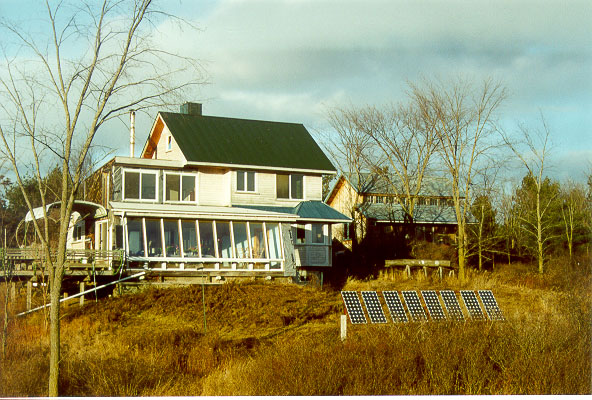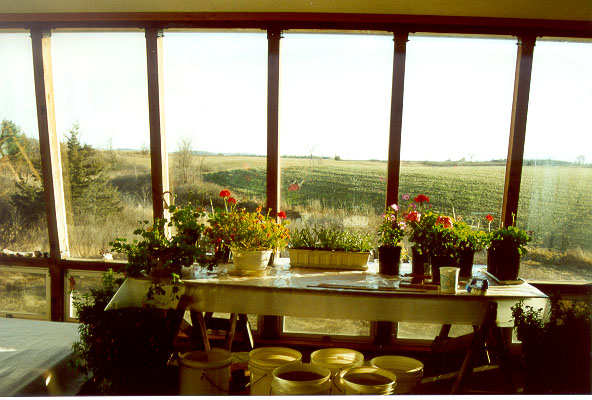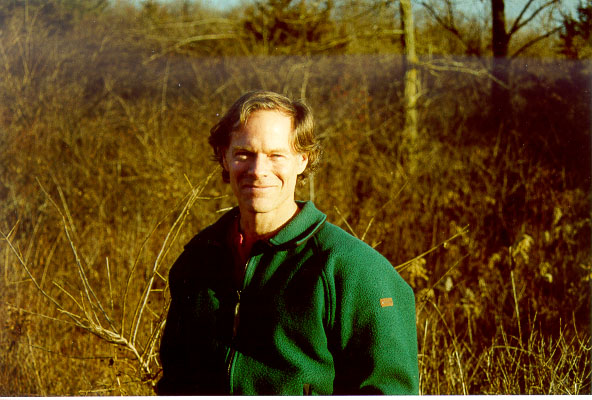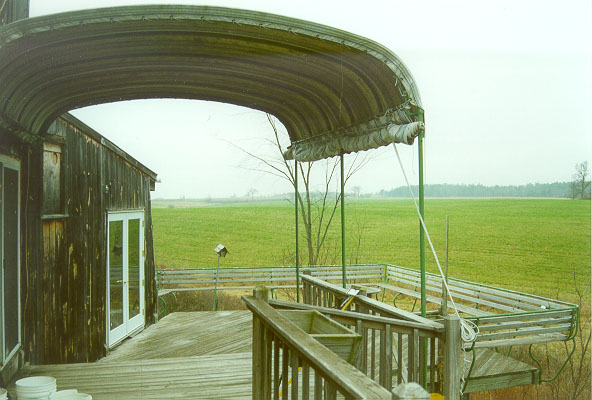

PAUL KENYON
Bridport, Vermont
Paul Kenyon believes in learning to create what you believe is beautiful and this desire surfaces throughout his home and his lifestyle. His house is mainly wind powered, with a small amount of recently installed photovoltaic cells. He lives completely “off the grid” in Bridport, on land that borders agricultural fields, just miles from the waters of Lake Champlain.
Why
wind?
Paul Kenyon moved to Vermont fifteen years ago and began renovating an old structure with his wife who had previously bought the land. The two buildings there have always been “off the grid”, without electrical power until the wind turbine was installed. Their decision to use wind resulted from the expense of installing power lines in such a remote area, as well as the desire to live independently. They were also enticed by the tax credits of the early 1980’s for alternative energy use. But their motivation was not necessarily “environmentally” inspired.
Paul Kenyon believes that the climate in Vermont is ideal for a wind and solar combination for a power source, though most of the power comes from wind. The couple researched the best method to install wind, and Paul’s background as an engineer added to their knowledge of the mechanics behind the system. But basically, they calculated the average wind speed at their house, and found it to be about 8.3 mph. The system they presently depend on is able to produce “usable” power from any winds over 11 mph, so any wind power under that speed is stored and used later.
Heating and Appliances
The renovation project they are working on has taken many years because they are doing everything themselves in their spare time and Paul incorporates a lot of hand woodwork into his design process. The careful design and sheer size of such a project has led to such a long process. But Paul believes that such results are worth the time.
 One
of their largest tasks was adding the green house to the original
structure, which brings passive solar heat to their house. The
greenhouse added 375 square feet to an original house of 670 square
feet. The greenhouse serves as heat source due to its southward
facing windows and slate floors. The couple grows plants and flowers
in the greenhouse to sell and give to the community.
One
of their largest tasks was adding the green house to the original
structure, which brings passive solar heat to their house. The
greenhouse added 375 square feet to an original house of 670 square
feet. The greenhouse serves as heat source due to its southward
facing windows and slate floors. The couple grows plants and flowers
in the greenhouse to sell and give to the community.
They use a wood stove
for further heat in the winter months, burning approximately 3 cords
of wood each year, not harvested from their own land. On top of that,
for rare occasions, he has a kerosene space heater. Paul is also
building a composting toilet for the house. They use a super
efficient refrigerator, which costs more money than a regular
refrigerator, but the amount of money he saves by having no electric
bills helps alleviate this cost. He has a gas powered convection oven
and a gas powered hot water heater. They use around 220 gallons of
gas each year, which is relatively low for the average family home in Vermont. They also have a backup
generator that is rarely used, now that he has installed photovoltaic
cells in his front yard. Before installing them, he used the
generator around 15-20 hours each year.
low for the average family home in Vermont. They also have a backup
generator that is rarely used, now that he has installed photovoltaic
cells in his front yard. Before installing them, he used the
generator around 15-20 hours each year.
The Kenyons use filtered and chlorinated rainwater from the roof for their drinking water, which is stored under the floor of their greenhouse in a 400-gallon tank. They also have a shallow well for showers and laundry which drains back into the surrounding land.
 The
Chosen Lifestyle
The
Chosen Lifestyle
Paul Kenyon’s path directed him many places before he eventually settled in Vermont. After graduating from college, he joined the engineering work force in Boston for many years, until he finally decided he was no longer satisfied with that lifestyle. He grew up on Long Island and was directed to follow a certain path, and he ultimately moved from that path to learn more about what he truly wanted for himself in life.
Paul’s decision led him to many new adventures, starting with a bike trip around the world. He had always enjoyed the outdoors and he wanted to see the world, so he thought a bike trip was the perfect means. His trip was initially planned to last a few months and only cover parts of Europe, but along the way he decided to use the money he had made to keep travelling. So he continued on biking in Asia, Australia, New Zealand, and then headed back to bike across the United States. He continued his biking travels around the world with a trip through South America, before he spent another entire year in Africa. He is also an avid climber and a board sailor. His passion for the outdoors is clear.
 Somehow
all of his experiences led him to settle in Vermont, with a simple
lifestyle of little impact on the land. He used his engineering
skills to contribute to the alternative energy field when he first
came to Vermont by designing instruments for the local windmill
industry. Now he has turned to writing and building boats while also
finishing up work on the house. He lives by his passion for personal
creative work. His house, his lifestyle, and his hobbies demonstrate
a deep appreciation for the natural world. Anyone who envisions the
windmill in their own backyard as a ”moving sculpture”
surely looks at the world with conscious eyes.
Somehow
all of his experiences led him to settle in Vermont, with a simple
lifestyle of little impact on the land. He used his engineering
skills to contribute to the alternative energy field when he first
came to Vermont by designing instruments for the local windmill
industry. Now he has turned to writing and building boats while also
finishing up work on the house. He lives by his passion for personal
creative work. His house, his lifestyle, and his hobbies demonstrate
a deep appreciation for the natural world. Anyone who envisions the
windmill in their own backyard as a ”moving sculpture”
surely looks at the world with conscious eyes.